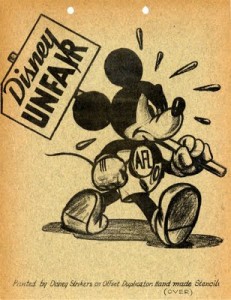Of Mice and Mien
 Today’s New York Times front page article on the dilemma facing the Walt Disney Company over revamping its icon über alles, Mickey Mouse, struck me as very odd, indeed. Aside from a certain perplexity regarding the significance of this issue over, say, the war in Afghanistan (relegated to the interior), the article’s claim that the corporation’s purportedly bold move to tamper with Mickey’s visage was unprecedented failed to note the notorious litigiousness of said corporation whenever outsiders dared to parody or alter in any way the rodent’s sacred features. Nor did the article mention the corporation’s influence over the promotion and passage of the 1998 Copyright Term Extension Act, which was in no small part created to preserve its profitable control of that face just as the latter was in danger of slipping into the public domain.
Today’s New York Times front page article on the dilemma facing the Walt Disney Company over revamping its icon über alles, Mickey Mouse, struck me as very odd, indeed. Aside from a certain perplexity regarding the significance of this issue over, say, the war in Afghanistan (relegated to the interior), the article’s claim that the corporation’s purportedly bold move to tamper with Mickey’s visage was unprecedented failed to note the notorious litigiousness of said corporation whenever outsiders dared to parody or alter in any way the rodent’s sacred features. Nor did the article mention the corporation’s influence over the promotion and passage of the 1998 Copyright Term Extension Act, which was in no small part created to preserve its profitable control of that face just as the latter was in danger of slipping into the public domain.
But there is a great tradition of monkeying around with Mickey’s mien. The late great Will Elder, in league with Harvey Kurtzman, established the bonafides of what would become Mad Magazine in its early comic book years with such brash send-ups of the sacred and profane as his brilliant 1955 “Mickey Rodent†(see above). Then there was the short-lived assault on Disney’s carefully cultivated saccharine style in a short series of underground comix called Air Pirates, which portrayed Mickey and his cohort of Disney pals committing acts of an un-family-friendly nature that probably blew out the windows of the Disney Company’s corporate headquarters (cartoonist Dan O’Neill actually succeeded in getting copies smuggled into a board meeting) before the corporation sued for copyright infringement in 1972.
 But, in quest of a teachable moment, for me the most significant rearranging of Mickey’s mug, not to mention disposition, occurred during the 1941 strike by Disney’s animators. The strike had a profound effect on Walt Disney’s politics and on postwar animation in general—delineated in Michael Denning’s (written with Holly Allen) illuminating essay, “‘Who’s Afraid of Big Bad Walt?’ Disney’s Radical Cartoonists,” in his The Cultural Front: The Laboring of American Culture in the Twentieth Century (New York, 1996), supplemented by the more recent anecdotal Tom Sito, Drawing the Line: The Untold Story of the Animation Unions from Bosko to Bart Simpson (Lexington, 2007). As evidenced by their leaflets and posters (see right) and rare film footage, striking Disney artists were not shy about using the characters they labored over daily to promote their cause.
But, in quest of a teachable moment, for me the most significant rearranging of Mickey’s mug, not to mention disposition, occurred during the 1941 strike by Disney’s animators. The strike had a profound effect on Walt Disney’s politics and on postwar animation in general—delineated in Michael Denning’s (written with Holly Allen) illuminating essay, “‘Who’s Afraid of Big Bad Walt?’ Disney’s Radical Cartoonists,” in his The Cultural Front: The Laboring of American Culture in the Twentieth Century (New York, 1996), supplemented by the more recent anecdotal Tom Sito, Drawing the Line: The Untold Story of the Animation Unions from Bosko to Bart Simpson (Lexington, 2007). As evidenced by their leaflets and posters (see right) and rare film footage, striking Disney artists were not shy about using the characters they labored over daily to promote their cause.
Pace the Times, one may only expect (dare I say hope) that the tradition of irreverent fair use manipulation of Mickey’s face continues— nay, blossoms—online.
Last 5 posts by Josh Brown
- The Civil War Draft Riots at 150 – A Public Event - June 17th, 2013
- Alfred F. Young - November 7th, 2012


